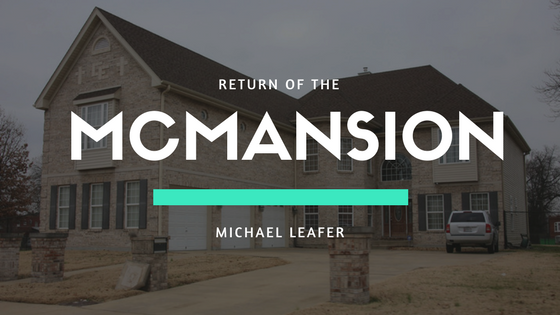A bloated house crouches on a plot a little too small for its width; its oddly-placed windows peer crookedly out at the identical structures plopped across the cul-de-sac. From far away, its architecture might look expensive, but it’s a mass-produced and strangely cheap kind of extravagance. While the house should look elegant and wealthy given its imposing size, it somehow…doesn’t.
Despite not being typified in any official capacity, McMansions are remarkably easy to recognize in a glance.
The cookie-cutter style of these homes took root in the early 2000s, and is inextricably linked to mentions of the housing bubble that preceded the Great Recession. Despite their typically cheap construction and tacky design, McMansions were popular in pre-recession years for the (relatively) inexpensive illusion of wealth that they provided.
However, the McMansion style fell out of fashion during the recession and has remained something of an unfashionable choice in the years since, as more and more young people flock to urban areas. However, an investigation conducted by the Washington Post’s Ana Swanson indicates that the passé style is making a steady – if slow – comeback as the housing market recovers. In her research, Swanson inspected the real estate site Zillow for McMansions and cookie-cutter communities by isolating their shared characteristics: their large sizes, recent constructions, suburban locations, and cluttered developments. Interestingly, she found that – contrary to what fashion and general belief would suggest – McMansions are making a comeback.
In her article, Swanson suggests that the quiet recurrence of the style has a number of causes: more millennials starting families in the suburbs, lower gas costs for commuters, and even an uptick in housing reality shows. The last category is particularly important, as it reveals that houses are no longer just residences to Americans. Instead, they represent a potential investment – as heightening housing prices have skewed the market to benefit sellers, flipping houses has become an attractive option for many homeowners.
For these would-be flippers, renovations are geared towards impressing a would-buyer with flashy interior additions such as marble countertops, impressive flooring, and flashy chandeliers. The quality of the work isn’t as important as how the final product looks upon a buyer’s quick glance. McMansions operate on the same principle, albeit on a larger scale. They sacrifice quality for flashy attributes – often to a tacky degree – in order to provide a cheaper way to present the appearance of wealth.
However, with such an emphasis on the short-term goal of impressing the buyer, a homeowner might do well to concern themselves with the long-term negatives of investing in a flipping-centered housing culture. If the slow, post-recession rise of McMansions is indeed one of the first signs of another housing bubble, overeager flippers could soon find themselves saddled with an expensively-renovated but cheaply-outfitted McMansion that – despite their investment – has very little long-term value.

